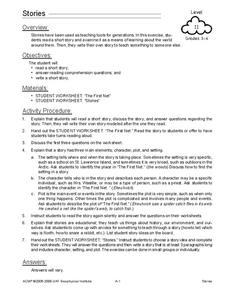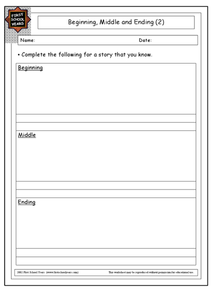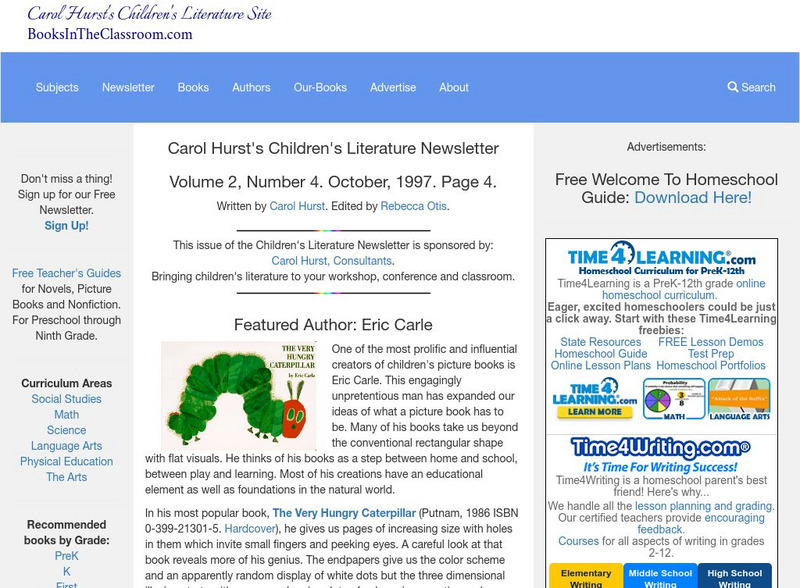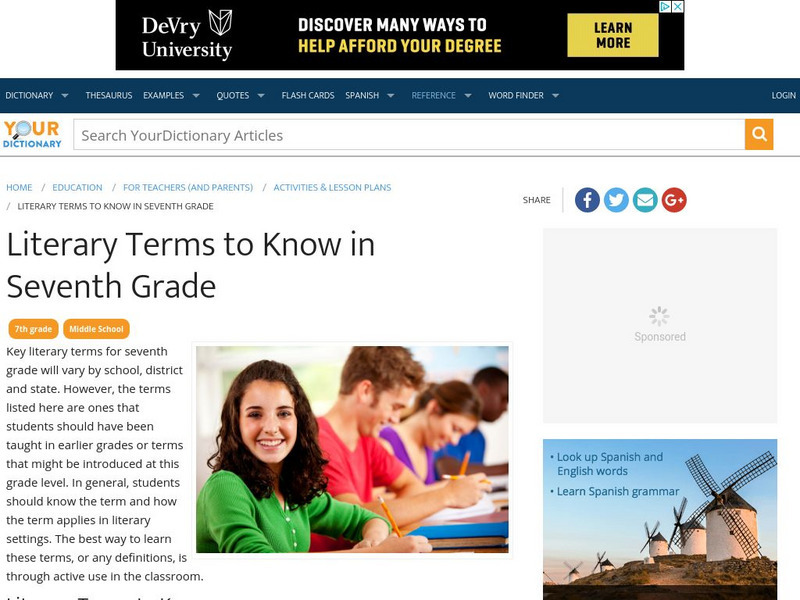Curated OER
Snow Globe Family
Kindergartners sequence the parts of a story using a snow globe as a setting. They will listen to Snow Globe Family and retell the parts of the story noting the beginning, the middle, and the end. Then they will make their own snow...
Curated OER
Movie Riddles: An ESL Activity to Get Student Talking About Movies
Enjoy the thrill of the movies with this ESL activity! Not only can learners talk about their favorite films, but in creating riddles about their chosen movies, they can practice the skills of context clues and deductive reasoning. This...
Curated OER
A Plump and Perky Turkey
Help readers recognize elements in a story. They will use pictures and text to gain meaning from written material. Have learners listen to the story A Plump and Perky Turkey and participate in a discussion. They recognize the...
Curated OER
Identifying Story Elements
Help your class identify story elements. They will discuss character, setting, problem, and solution after reading a story. A graphic organizer will help them to identify various elements with guided practice and independent practice...
Curated OER
Telling A Story
Students discover that every story has a start, middle and end. In this literature lesson plan, the teacher models using a picture to show the parts of the story. Students each take a picture and tell a story using start, middle and end.
Curated OER
Beginning and End
Are you working onevent sequence in your kindergarten class? Use a reading activity to have your kids discuss events from the story, and put them in order. They then cut and paste them in the correct order. A great project for any story!
Curated OER
Developing a Story Plan
In this developing a story plan worksheet, students describe each of the three parts of their story. Students create an opening, sequence of events, and a closing.
Curated OER
The Higher Power of Lucky
Students complete activities using the book The Higher Power of Lucky. In this literature lesson, students read the story and identify the parts of the story. They create a wind chime like that found in the book.
Curated OER
Stories
Students read a short story and answer questions. For this comprehension lesson, students read a short story and complete a worksheet answering comprehension questions and identifying the parts of a story. Students create their own...
Curated OER
The Great American Fire Drill
Students read a story about fire safety and create their own ending to the story in order to learn about fire escape plans and to demonstrate their writing skills. In this fire safety lesson, students discuss the parts of a story, read...
Curated OER
Beginning, Middle, Ending (2)
In this story structure learning exercise, students use a story map and write down the beginning, middle, and ending of a story they know.
Utah Education Network
Uen: Create a Book (Grade 3 6)
Students will illustrate and write their own story.
Curated OER
Mc Graw Hill: Major Events
Learn how writers use details to describe major events in a story.
ReadWriteThink
Read Write Think: It Doesn't Have to End That Way
Literary response and prediction are the focus of this lesson plan. Knowing story structure is an important skill for literary analysis, and this gives teachers a way to help students develop this skill. Includes links to web resources,...
Other
Prezi: Finding the Central Message
The central message of a fictional story is often hidden between the lines. Learn how to find it in the characters and events in the story.
Books in the Classroom
Carol Hurst's Children's Literature Site: Eric Carle
What do you know about Eric Carle, the author? This Carol Hurst site highlights some interesting facts about this author's life and refers to some of his books.
Scholastic
Scholastic: Eric Carle Biography
Discover more about your favorite children's author, Eric Carle, when you visit this biography. Students and teachers will gain a new perspective of this author's life and work.
Love To Know Media
Your Dictionary: Literary Terms to Know in Seventh Grade
This site lists and briefly defines the literary terms 7th graders should know including types of writing, literary devices, sound devices, figurative language, and parts of a story,
Success Link
Success Link: Characters, Setting, Plot, Conclusion, and Summarizing a Story
This lesson plan offers a step-by-step procedure for teaching students how to identify story elements and to summarize a story. It explains how to use a "Who Am I" activity, as well as a linkage activity in identifying characters and...
Alabama Learning Exchange
Alex: Soaring With Literary Elements and Devices
In this instructional activity, students will observe literary elements and devices in a variety of chapter books. Students will be paired with a partner and allowed to choose one book to identify literary elements. Using digital cameras...
Alabama Learning Exchange
Alex: I Want My Half
In this lesson, the children will identify parts of a whole using modeling clay, participate in an interactive web lesson, participate in an interactive web game, and construct a fraction poster. The activities are used as instructional...
Alabama Learning Exchange
Alex: Savvy Story Structure
During this lesson, students learn to actively engage in reading by becoming more familiar with the elements of a story. Students will be required to think at a higher level and will enhance their understanding of selected passages and...
Alabama Learning Exchange
Alex: Story Elements
During this lesson, students will analyze what distinguishes the stories they love. Reading and reviewing their favorite books will help students begin to identify elements of a story. Students have the opportunity to navigate the...
Alabama Learning Exchange
Alex: Sandwich Story Starters
These simple activities actively reinforce the importance of writing a story that is complete: one that has a good, solid beginning; a middle of substance, detail, and high interest; and a satisfying ending.

























